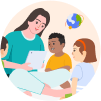Head Start Curriculum Standards
Head Start is a federally-funded program that works with low-income children and families to provide early education services. The program, which began in 1964, was conceived to provide more equity in our education system and give children from impoverished families a foundation to build future success. Head Start was only one cog in the wheel of the Johnson Administration’s “War on Poverty.”
Although Head Start may not have provided an easy answer to solving the problem of generational poverty, the widely-recognized program takes a comprehensive approach to early childhood education. Serving pregnant women, families, and children up to kindergarten age, Head Start and Early Head Start programs emphasize family engagement. However, engagement is a tall order for families already struggling to meet the day-to-day grind required for survival. As such, the program utilizes a holistic approach to education that considers physical and mental health, cultural sensitivity, and familial support.
Head Start is no slouch when it comes to developing strategies to meet the needs of children and families, as evidenced by its many guidelines for the program’s structure and services. The program’s website includes an abundance of resources for every aspect of program implementation, including data collection, organizational structures*, and provision of the services themselves. Of course, curriculum development is no exception, and there is a considerable amount of information available to educators who are developing a Head Start curriculum.
The Improving Head Start School Readiness Act
In 2007, legislators passed the Improving Head Start School Readiness Act, which defined minimum standards for Head Start and Early Head Start Programs. The law consisted of several provisions designed to improve program offerings and quality outcomes; these include:
- The alignment of statewide standards and Head Start school readiness goals.
- Requiring higher level qualifications for Head Start Educators.
- Requiring states to form State Advisory Councils on Early Care and education.
- Increased monitoring for Head Start programs, including yearly fiscal reporting and an annual review of child outcomes.
- A redesign of the Office of Head Start Training and Technical Assistance Program.
- Development of a system for grant renewals.
- Revision of the Head Start Program’s performance standards.
What does all this mean? At the time of the law’s enactment, it meant that Head Start Programming had to undergo substantial change for compliance. Today, the Improving Head Start School Readiness Act and its periodic updates mean that the Head Start program has to create specific performance standards to which all local Head Starts must conform.
Head Start Program Performance Standards
The Head Start program created the Head Start Program Performance Standards (HSPPS) to ensure that all Head Start and Early Head Start programs had a formal program structure. The guidelines put forth by the organization include instructions for every aspect of the program. The HSPPS consists of the following five parts:
- Part 1301: Program Governance
- Part 1302: Program Operations
- Part 1303: Financial and Administrative Requirements
- Part 1304: Federal Administration Procedures
- Part 1305: Definitions
Under each of these designations, the agency addresses multiple related aspects of programming in a number of subparts. The chart below shows which parts of the HSPPS cover the various aspects of programming.
Part Programming Aspects Covered Program Governance · Governing body
· Policy council and policy committee
· Parent committees
· Training
· Impasse procedureProgram Operations · Eligibility, Recruitment, Selection, Enrollment, and Attendance
· Program Structure
· Education and Child Development Program Services
· Health Program Services
· Family and Community Engagement Services
· Additional Services for Children with Disabilities
· Transition Services
· Services to Enrolled Pregnant Women
· Human Resources Management
· Program Management and Quality ImprovementFinancial and Administrative Requirements · Financial Requirements
· Administrative Requirements
· Protections for the Privacy of Child Records
· Delegation of Program Operations
· Facilities
· TransportationFederal Administration Procedures · Monitoring, Suspension, Termination, Denial of Refunding, Reduction in Funding, and their Appeals
· Designation Renewal
· Selection of Grantees
· Replacement of American Indian and Alaska Native Grantees
· Head Start Fellows Program
As you can see, the program leaves very little unstructured as it continues to strive for excellence. With this roadmap, local Head Start programs can comply with the regulations laid out by the Improving Head Start Services Act and provide the best possible programming for young learners and their families.
Head Start Learning Standards
So, where do the curriculum requirements fall in the HSSRA? The program addresses curriculum requirements under the Education and Child Development Program services subpart 1302.32, which contains two sections: curricula and adaptations. The section on curricula deals with the requirements for standard curriculum development. The section on adaptations gives guidelines for programs that need to adapt the curriculum for the needs of specific populations.
Section Specifications Curricula Head Start programs need to develop curricula based on developmentally appropriate research into early childhood curricula, including enhancements. " " Programs should support staff to implement curricula effectively. Programs will monitor curriculum implementation and fidelity and provide support, feedback, and supervision for continuing education. Adaptations When individual programs make adaptations to support specific populations, they should use an external early childhood education curriculum or content area to develop them. In addition, the program needs to assess whether the curriculum meets the required school readiness goals.
The curricula of any Head Start program must also adhere to the following three regulations:
- Curricula are based on scientifically valid research and standardized training procedures, with curriculum materials to support implementation.
- Curricula align with Head Start Early Learning Outcomes Framework and the early learning and development standards in the state in which the program operates. Programs must show measurable progress toward development.
- Curricula have an organized developmental scope and sequence, including plans and materials for learning that are based on developmental progressions and best practices for child learning.
High Quality Head Start Curriculum Development
The Head Start program recommends a researched-based curriculum. What does that mean? A research-based curriculum is a curriculum developed from current studies on how children learn. In addition, a research-based curriculum has several characteristics that affect child development:
- It is content-rich.
- It provides a broad range of varied experiences that promote learning and development.
- It builds on children’s interests, prior knowledge, and experience.
- It offers sequential learning experiences based on developmental progression.
These guidelines leave programs a lot of room to work with a curriculum that meets the needs of the population they serve. Thankfully, the Head Start program also provides a wealth of resources for programs as they develop their curricula. One such resource, offered by the National Center on Early Childhood Development, Teaching, and Learning (NCECDTL), aids educators with a guide for curriculum development. The guidelines consider the following eight factors:
| Factor | Things to Consider |
| Your Curriculum’s Resources | · What is the purpose of the resources? · Do you plan to use them every day or only sometimes? · How much flexibility do you have in using it? · Do you need to adjust it to meet the needs of all the children in the classroom? · Do the resources your children and family will use reflect their cultures, languages, and ethnicities? · Are the resources available in the children’s home languages? · Do you need professional development to use any of the resources? |
| Your Curriculum’s Approach to Teaching and Learning | · How does your chosen curriculum describe its approach to teaching? Some examples of approach include: >> A curriculum can use an approach that values building relationships with the families. >> A curriculum can use an approach that works with the children’s interests. · Does the curriculum help you to respond to each child’s strengths, needs, and cultural background? · Does it help you partner with diverse families who speak languages other than English? · Does it support individualization for children with disabilities, special needs, and non-English speakers? |
| Your Curriculum’s Learning Domains | · Which learning domains does the curriculum cover? · How are learning domains integrated into daily activities? · How do the domains align with the Head Start Early Learning Outcomes Framework? |
| Your Curriculum’s Learning Goals | · What learning goals does your chosen curriculum include? · Are your curriculum’s learning experiences connected to its learning goals? · How will you use your curriculum’s learning goals to individualize learning for the children in your care? · Does your curriculum guide you to adapt it for children with special needs and learning disabilities? · Does your curriculum guide you to set learning goals in each language the child is learning? · How will you involve families when setting learning goals? |
| Your Curriculum’s Ways of Organizing the Learning Environment | · Does your curriculum suggest ways to set up the learning environment? · Will your learning environment support learning in all domains? · Will your learning environment support all the children in your care, including those with special needs, learning disabilities, and children who are dual-language learners? · Does your learning environment reflect the children’s cultural backgrounds and include familiar family objects from each child’s home? |
| Your Curriculum’s Routines and Schedules | · Does your curriculum help you set up a daily schedule and establish classroom routines? · Do your schedules and routines support learning and development in different domains? · Does your schedule allow for adaptation to the children’s needs and interests? · Are your routines responsive to the cultural and language backgrounds of the children in your care? |
| Your Curriculum’s Ways of Planning and Implementing Learning Experiences | · How does your curriculum define learning experiences? · What resources and materials will support classroom activities? · How will the learning experiences support developmental goals in all learning domains? · How can you adapt activities to meet the needs of children at different developmental levels? · How can you adapt learning experiences for children with disabilities? · How does your curriculum help you learn about and build on a child’s experiences in a culturally appropriate way? · How can you individualize experiences for dual-language learners? |
| Your Curriculum’s Ways of Engaging Families | · What resources does your curriculum provide for familial engagement? · What resources does your curriculum provide to promote continued learning in the home? · How does your curriculum engage families in open houses, family nights, and other special school activities? · What ideas does your curriculum provide for including families of children with disabilities and special needs? · What ideas does your curriculum provide for engaging non-English speaking families? · What notes and materials can you provide to families in their home language? |
As you can see, the Head Start organization recommends the implementation of a thoughtful, culturally appropriate, and inclusive curriculum built around developmental needs and family engagement. You can click here for the complete resource.
The Head Start Early Learning Outcomes Framework: An Overview
Since Head start predicates curriculum development on meeting the Head Start Early Learning Outcomes Framework (ELOF), it makes sense to give an overview of the goals and what they encompass. To be concise, the ELOF outlines the skills, behavior, and knowledge that Head Start programs must foster in all children who participate in the program. The program intends for local Head Start organizations to reference the ELOF when developing a curriculum to ensure they are fostering an environment that will allow development in five specific domains:
- Approaches to Learning
- Social and Emotional Development
- Language and Literacy
- Cognition
- Perceptual, Motor, and Physical Development
Although Head start lists all these domains for both infant/toddlers and preschoolers, the preschool domain has some slight differences. Namely, the program split the Language and Literacy domain into two sub-domains: Language and Communication, and Literacy. Similarly, the Cognition domain also has two sub-domains for preschoolers: Mathematics Development, and Science Reasoning. This extra definition of the domains happens because learning becomes more differentiated as children grow.
Overall, Head Start embeds its commitment to creating an environment that fosters the best possible outcomes for children and families throughout the program. Within all the guidelines, resources, and structures in the organization remains a sincere wish to engage with children and families in a respectful and appropriate way, support their varied needs, and promote a better future.
Supporting Those Who Support the Learning Process
Children learn best with consistent messages, lessons, and routines, making it impossible to understate the value of building a community around our children. And while the Head start program makes a significant effort to build that community, it also faces many obstacles. So how can the program optimize its resources and ease the burden on families who are just trying to survive and may not have time for community-building?
Programs need to make things as easy as possible for families and educators alike. One way they can achieve this goal is through streamlining communication, record-keeping, and data collection. Software packages, like the one created by Learning Genie, can help the process immensely.
Learning Genie is not only a leader in early educational software but a thoughtfully developed platform made with early education in mind. Even better, Learning Genie’s developers created specific modules to meet the particular needs of Head Start programs. Head start administrators will find the data module especially attractive, while educators and parents will enjoy myriad other benefits:
- All-in-one, data-driven family engagement suite for community building.
- An easy-to-use app.
- Language translation for 104 languages.
- Text messaging between families and educators.
- A family engagement module.
- Push notifications and event reminders.
- Auto translation for messaging.
- Text-to-speech for fast documentation.
- Data monitoring and reporting.
- Batch reporting.
- In-app state-resource data.
- Flexible filters for data review.
- In-app assessments.
- Interactive parenting tips.
- Quick report entry.
- Offline and draft modes.
Educators can use Learning Genie to send pictures and videos to parents, giving families a window into their child’s day. They can also share classroom resources, like books and songs, and quickly print portfolios for conferences. The software platform saves money, eliminates paper portfolios, and eases data collection and review.
In response to Covid, Learning Genie updated its platform to include distance learning and other measures that support Head Start. These features include:
- Digital daily health screenings that families can fill out on the app for real-time data collection.
- Contactless check-ins and check-outs.
- Real-time data tracking and a dashboard for quick review and decision making.
- Virtual learning events and reminders for families.
- Digital media learning, with eBook libraries.
- In-kind tracking tool for in-kind hours.
- Digital portfolio for distance learners.
Regardless of the curriculum you choose, Learning Genie can support your classroom, help educators build productive relationships with parents, and ease your data collection and review process. In addition, the platform gives parents the resources to continue learning in the home and the ability to be in constant contact with the classroom.
The Importance of Curriculum Development for Ongoing Educational Success
There is no denying that early education makes a difference for those who have access to it, and Head Start provides access to those most in need. Why is learning in the first five years of life so essential? Early education sets the stage for future academic achievement and success. Infants, toddlers, and preschoolers are undergoing rapid growth and development. When this growth is adequately nourished and encouraged, they gain the school readiness skills they need to flourish well into the future.





